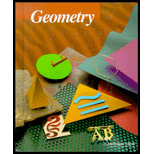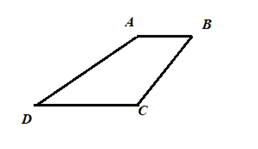
a.
To find what is true about all the drawn quadrilaterals.
a.
Answer to Problem 27WE
The adjacent
Explanation of Solution
Given:
Random quadrilaterals with one pair of parallel sides.
Draw random quadrilaterals with one pair of parallel side.

By observing the quadrilaterals,
In any random quadrilateral with one side paralleltwo pairs of adjacent angles formed between the parallel sides and one of the non-parallel side, add up to 180 degrees.
Conclusion: Therefore, the adjacent angles formed between the parallel sides and one of the non-parallel side are supplementary.
b.
To state and prove the converse of that the adjacent angles formed between the parallel sides and one of the non-parallel side are supplementary.
b.
Explanation of Solution
Given:
A quadrilateral

In quadrilateral
Conclusion:
Therefore,
c.
To write: a biconditional about pairs of opposite angles.
c.
Answer to Problem 27WE
Opposite angles can be equal or supplementary.
Explanation of Solution
Given:
A quadrilateral
Concept used:
In a quadrilateral the opposite angles can be equal like in Rhombus or Square.
And the opposite angles can also be supplementary at the same time like in a Square and Rectangle.
Conclusion:
Therefore, in a quadrilateral the opposite angles can be equal and supplementary at the same time.
Chapter 3 Solutions
McDougal Littell Jurgensen Geometry: Student Edition Geometry
Additional Math Textbook Solutions
Basic Business Statistics, Student Value Edition
Elementary Statistics (13th Edition)
University Calculus: Early Transcendentals (4th Edition)
Calculus: Early Transcendentals (2nd Edition)
Elementary Statistics: Picturing the World (7th Edition)
- Door 87.5in to 47 living 44.75 Closet 96in Window ISS.Sin 48in Train Table 96in 48in 132:2 Windowarrow_forward39 Two sides of one triangle are congruent to two sides of a second triangle, and the included angles are supplementary. The area of one triangle is 41. Can the area of the second triangle be found?arrow_forwardA parallelogram with an area of 211.41 m^2 hast a base Thatcher measures 24.3m. Find ist height.arrow_forward
 Elementary Geometry For College Students, 7eGeometryISBN:9781337614085Author:Alexander, Daniel C.; Koeberlein, Geralyn M.Publisher:Cengage,
Elementary Geometry For College Students, 7eGeometryISBN:9781337614085Author:Alexander, Daniel C.; Koeberlein, Geralyn M.Publisher:Cengage, Elementary Geometry for College StudentsGeometryISBN:9781285195698Author:Daniel C. Alexander, Geralyn M. KoeberleinPublisher:Cengage Learning
Elementary Geometry for College StudentsGeometryISBN:9781285195698Author:Daniel C. Alexander, Geralyn M. KoeberleinPublisher:Cengage Learning

